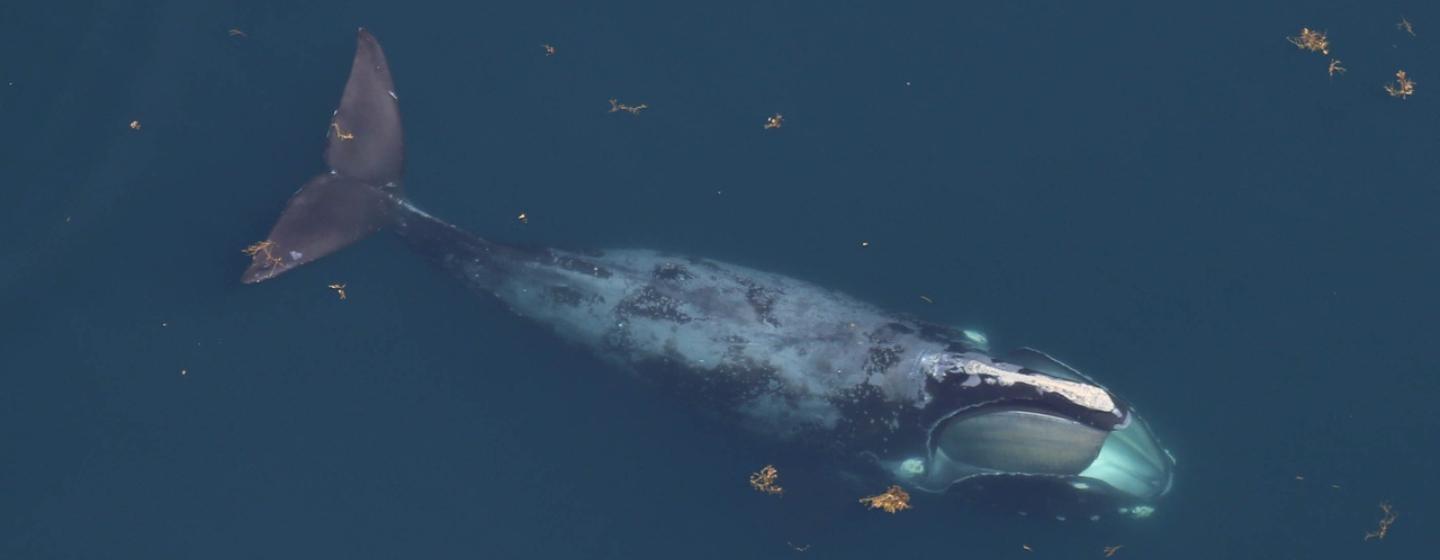Aerial Survey of Endangered Whales Off NC Coast


There was good news and bad news for North Atlantic right whales near the end of 2024.
First, the good news.
The first right whale of the 2024–25 calving season was spotted off the North Carolina coast in late November. And not long after that, the Florida Fish and Wildlife Research Institute reported the first right whale calf of the season with its mom by a boater off Cape Romain, South Carolina.
“The birth of a new calf in this critically endangered population is cause for celebration and hope,” said Kim Elmslie, Oceana Canada’s campaign director, in a release announcing the whale calf spotting. Oceana is a nonprofit focused on ocean conservation. “This new calf represents a beacon of possibility for a fragile whale population, which now only numbers around 370 individuals, including just 70 breeding-age females.”
Those small numbers make the bad news worse.
A juvenile right whale was spotted entangled in fishing gear off the North Carolina coast in mid-December. NOAA Fisheries biologists call the event a “serious injury” case, meaning the whale would likely die. It was the third documented right whale entanglement along the east coast in December.
All that news, good and bad, is related to why researchers will be flying every day (weather permitting) from November 15, 2024, through April 15, 2025—right whale calving season—to monitor the species.
North Atlantic right whales have been listed as endangered under the Endangered Species Act since 1970, but now, according to NOAA’s website, “North Atlantic right whales are approaching extinction.”
In 2017, elevated mortalities in North Atlantic right whales caused NOAA to declare an “unusual mortality event” for the species because of human activities, including strikes by ships and entanglements in fishing gear. From the declaration through the end of 2024, 41 whales were found dead and another 39 were so severely injured it is believed they would die.
The North Atlantic right whale is one of three right whale species. The others include the North Pacific right whale, found in the North Pacific Ocean, and the Southern right whale, found in the Southern Hemisphere.
Right whales are baleen whales, which means they feed on tiny crustaceans by straining them out of huge amounts of ocean water through baleen plates in their mouths. Think of a giant sieve filtering out tiny, tiny creatures.
North Atlantic right whales used to be a favorite target of whalers because they were rich with whale oil, were often found near shore, swam slowly and tended to float when killed. In fact, some say that’s how they got their name: they were the “right” whales to hunt.
An estimated 21,000 right whales used to be found in the Atlantic Ocean, but their numbers dropped to fewer than 100 by the 1920s. Hunting right whales was banned in 1935, and the population grew to about 483 by 2010. But the numbers are dropping again.
Scientists say only about 370 right whales survive today. About 70 are reproductive females, which carry their calf for one year and give birth to only one calf each season. The whales migrate between feeding grounds in the Labrador Sea (in the North Atlantic) and winter calving areas off Georgia and Florida. Unfortunately, it’s an area with heavy shipping traffic, which is why scientists say vessel strikes and entanglements in fishing gear are the biggest threats to the remaining North Atlantic right whales.
The Clearwater Marine Aquarium Research Institute’s North Carolina Early Warning System started collecting data about right whales in the early 2000s. Three-person teams gathered information and aerial images along the North and South Carolina coasts. It shut down in the mid-2010s when funding stopped.
But in 2019, the Army Corps of Engineers rescued the monitoring program. Since then, survey teams based in Beaufort, NC; Georgetown, SC; and St. Simons Island, GA, as well as a team with the Florida Fish and Wildlife Conservation Commission take to the skies to survey hundreds of miles of the southeast coast during right whale calving season. Once whales are spotted, they are photographed and their location is recorded. The information is shared with federal, state and nonprofit research organizations.
In addition to counting the whales, researchers also add the sighting and location to a whale map, which is relayed to the maritime community and the public. By law, ships must stay 500 yards (about the height of the Empire State Building) away from right whales.
There are also seasonal management areas with set speed limits for shipping that stretch from the mid-Atlantic coast down to Florida. To reduce the risk of vessel strikes during calving season, large ships must maintain a speed of 10 knots or less.
You can help with the whale spotting program. Anyone who sees a right whale from Florida to North Carolina is asked to call 877-WHALE-HELP (877-942-5343). If you see one from Virginia to Maine, call 866-755-6622.